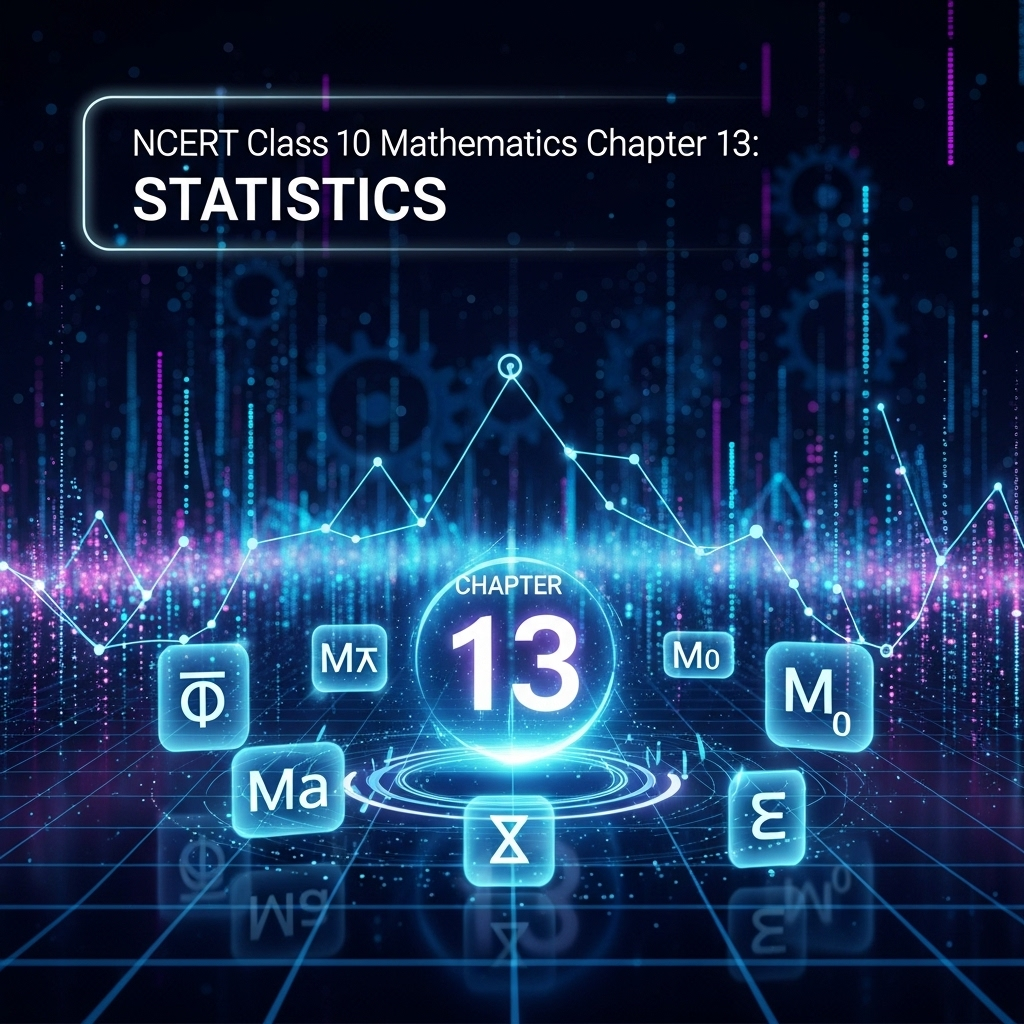Complete Solutions and Summary of Statistics – NCERT Class 10, Mathematics, Chapter 13 – Summary, Questions, Answers, Extra Questions
Comprehensive summary and explanation of Chapter 13 'Statistics', covering the study of data collected in ungrouped and grouped forms, computation of mean, median, and mode for grouped data, methods including direct, assumed mean, and step-deviation methods, cumulative frequency, frequency curves (ogives), and practical problems with detailed solutions based on NCERT Class X Mathematics.
Updated: 1 month ago
Categories: NCERT, Class X, Mathematics, Summary, Extra Questions, Statistics, Data Handling, Mean, Median, Mode, Frequency Distribution, Chapter 13

Statistics
Chapter 13: Mathematics - Ultimate Study Guide | NCERT Class 10 Notes, Questions, Examples & Quiz 2025
Full Chapter Summary & Detailed Notes - Statistics Class 10 NCERT
Overview & Key Concepts
- Chapter Goal: Extend mean, median, mode to grouped data; cumulative frequency and ogives. Exam Focus: Calculations, interpretations. 2025 Updates: Data analysis in real life. Fun Fact: Statistics from 'state' for governance. Core Idea: Summarize large data. Real-World: Surveys, averages.
- Wider Scope: Data science foundation, research.
13.1 Introduction
- Builds on Class 9: Ungrouped to grouped data, graphs (bar, histogram, polygon).
- Measures of central tendency: Mean, median, mode for ungrouped; extend to grouped.
- Cumulative frequency: Distribution and curves (ogives).
- Importance: Handle large data meaningfully.
13.2 Mean of Grouped Data
- Mean \( \bar{x} = \frac{\sum f_i x_i}{\sum f_i} \), where \( x_i \) observations, \( f_i \) frequencies.
- For grouped: Use class marks \( x_i = \frac{\text{upper} + \text{lower}}{2} \).
- Direct Method: \( \bar{x} = \frac{\sum f_i x_i}{n} \). Suitable for small values.
- Assumed Mean Method: Choose a, \( d_i = x_i - a \), \( \bar{x} = a + \frac{\sum f_i d_i}{n} \). Reduces calculations.
- Step Deviation Method: \( u_i = \frac{x_i - a}{h} \), \( \bar{x} = a + h \frac{\sum f_i u_i}{n} \). For common h (class size).
Example 1: Marks of 30 Students
- Ungrouped mean: 59.3. Grouped (15 width): 62 (approximate).
- Direct: Table with fi xi.
- Assumed a=47.5, di, mean 62.
- Step h=15, ui, mean 62.
13.3 Mode of Grouped Data
- Mode: Most frequent value.
- For grouped: Modal class (highest fi).
- Formula: \( \text{mode} = l + \left( \frac{f_1 - f_0}{2f_1 - f_0 - f_2} \right) h \), l lower limit, f1 modal fi, f0 previous, f2 next, h size.
- Assumptions: Uniform distribution in modal class.
Example: Mode Calculation
- Data with modal class 20-30 (f=10), previous 8, next 7: Mode = 20 + (10-8)/(20-8-7)*10 = 20 + 4 = 24.
13.4 Median of Grouped Data
- Median: Middle value when arranged.
- For grouped: Cumulative frequency cf, find class where n/2 lies.
- Formula: \( \text{median} = l + \left( \frac{\frac{n}{2} - cf}{f} \right) h \), l lower, cf previous cum, f class freq, h size.
- Even n: Average of n/2 and n/2+1.
Example: Median
- n=50, n/2=25 in class 30-40 (cf=20 previous, f=15): Median=30 + (25-20)/15 *10 =30+3.33=33.33.
13.5 Graphical Representation of Cumulative Frequency Distribution
- Ogives: Less than (upper limits vs cf), more than (lower vs cf descending).
- Median: Intersection of ogives x-coordinate.
- Uses: Estimate medians, quartiles.
Example 2: Female Teachers Percentage
- Classes 15-25 etc., fi=6,11,7,4,4,2,1.
- Mean 39.71 by all methods.
Exercise 13.1-13.8
- Mean, mode, median calculations for various data.
- Ogives drawing, median from graph.
13.6 Summary
- Methods for mean, formulas for mode/median.
- Ogives for cumulative.
Why This Guide Stands Out
Complete chapter coverage: Notes, examples, Q&A (all NCERT + extras), quiz. Student-centric, exam-ready for 2025. Free & ad-free.
Key Themes & Tips
- Central Tendency: Mean, median, mode.
- Grouped Data: Methods to simplify.
- Ogives: Graphical median.
- Tip: Choose method based on data size; verify calculations.
Exam Case Studies
Data tables for mean/median/mode; ogive interpretations.
Project & Group Ideas
- Survey data, compute measures; draw ogives.
This section provides over 3 pages of detailed content, covering all subtopics from introduction to summary, with formulas and examples explained step-by-step for thorough understanding.
Group Discussions
No forum posts available.


